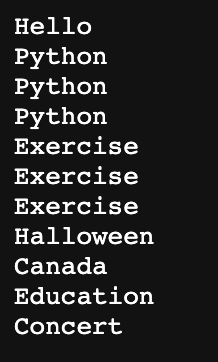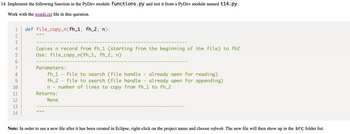
Database System Concepts
7th Edition
ISBN: 9780078022159
Author: Abraham Silberschatz Professor, Henry F. Korth, S. Sudarshan
Publisher: McGraw-Hill Education
expand_more
expand_more
format_list_bulleted
Question

Transcribed Image Text:Hello
Python
Python
Python
Exercise
Exercise
Exercise
Halloween
Canada
Education
Concert

Transcribed Image Text:14. Implement the following function in the PyDev module functions.py and test it from a PyDev module named t14.py:
Work with the words.txt file in this question.
123 45
2
4
5
6
7
8
9
10
11
12
13
14
def file_copy_n(fh_1, fh_2, n):
11 11 11
Copies n record from fh_1 (starting from the beginning of the file) to fh2
Use: file_copy_n(fh_1, fh_2, n)
Parameters:
fh_1 - file to search (file handle - already open for reading)
fh_2 - file to search (file handle - already open for appending)
n - number of lines to copy from fh_1 to fh_2
Returns:
None
|| || ||
Note: In order to see a new file after it has been created in Eclipse, right-click on the project name and choose refresh. The new file will then show up in the Src folder list.
Expert Solution
This question has been solved!
Explore an expertly crafted, step-by-step solution for a thorough understanding of key concepts.
Step by stepSolved in 3 steps with 1 images

Knowledge Booster
Learn more about
Need a deep-dive on the concept behind this application? Look no further. Learn more about this topic, computer-science and related others by exploring similar questions and additional content below.Similar questions
- Python - Text Processing Write a function copy(x, y) that can copy a file x into another file y. Use demo.txt as the input to verify your function. _Hint_: use functions open( ), read( ), write( ), and close( ).arrow_forwarda. Implement the following function in Python. Do not copy the docstring into answer. def get_record (fh, n): 111111 Find the n-th record in a comma-delimited sequential file. Records are numbered starting with 0. Use: record = get_record (fh, n) Parameters: fh - file to search (file - open for reading) n - the number of the record to return (int > 0) Returns: #1 #111 record - a list of the fields of the n-th record if it exists, an empty list otherwise (list) Paragraph b- Write a testing program to test the function from part a. The program should ask the user for a fil V 8⁰ BI Uv Αγ + v MacBarrow_forwardWrite a program that computes and prints the average of the numbers in a text file. You should make use of two higher-order functions to simplify the design. Ask the user for the name of the .txt file that contains the list of numbers. Include your code as usual in a .txt AND .py file. Create and use a .txt file to test your code using the numbers 78, 54, 22, 90, 15, 7.arrow_forward
- Plz solve assignment 5 by using assignment 8, use c programming and plz don't use any other libraries other than stdio . harrow_forwardWrite a C++ function (along with helper functions if required) that takes a file stream as a parameter and prints out the maximum negative number in the given file. Do not need to write the main function. An example: [Example file contents] 4 -2 8 12 -8 9 3Prints: Maximum Negative number -2arrow_forward****IN PYTHON! Write a function named file_stats that takes one string parameter (in_file) that is the name of an existing text file. The function file_stats should calculate three statistics about in_file: the number of lines it contains, the number of words and the number of characters, and print the three statistics on separate lines. For example, the following would be the correct input and output:>>> file_stats('created_equal.txt')lines 2words 13characters 72Note: The number of characters may vary slightly between operating systems. Similarly, the number of lines may vary by 1 line, depending on the method used to calculate it. I attached a picture of my code so far and a picture of what the text file reads.arrow_forward
- in c with commentsarrow_forwardpls code in pythonplagiarism: This Boolean function takes two filenames. If any line occurs in both files, return True.If not, return False. I suggest using nested loops. With nested loops, we call the loop that is in thebody of the other loop, the "inner loop". The loop that contains the inner loop is the "outer loop". Openthe second file inside the outer loop:for line1 in file1:file2 = open(fname2)for line2 in file2:Python only lets you read the file once per open, so you need this order of instructions. Make sure yourreturn False is outside of both loops. Otherwise, you will only compare the first two lines of thefiles. Make sure you close the file that gets read repeatedly after the inner loop but still inside the outerloop.Here is some (more complete) pseudocode to get you started:open file 1for line1 in file 1open file 2for line2 in file 2:if line1 == line2:return Trueclose file 2return Falsearrow_forwardI need help on my python assignment.arrow_forward
- Write a C code to take input from an input .txt file and write into an output file. The input file should have int type values and the output file should contain the square of each inputfrom the input file. Must use file type pointers implementation. A sample input and output are given as follows:Input:1 2 3 4 5Output:1 4 9 16 25arrow_forwardWrite a function in python named "read_words" that declares a parameter for a filename and returns a collection of unique words in the file. Even though words.txt contains a single word per line, you should not assume that this is true of every file. For example, if the line is a sentence, you should split the line into individual words before storing each word in your collection. Handle any errors that occur by printing a detailed error message. Hint: the Python set works like Java's HashSet.arrow_forwardCreate the following in C++arrow_forward
arrow_back_ios
SEE MORE QUESTIONS
arrow_forward_ios
Recommended textbooks for you
 Database System ConceptsComputer ScienceISBN:9780078022159Author:Abraham Silberschatz Professor, Henry F. Korth, S. SudarshanPublisher:McGraw-Hill Education
Database System ConceptsComputer ScienceISBN:9780078022159Author:Abraham Silberschatz Professor, Henry F. Korth, S. SudarshanPublisher:McGraw-Hill Education Starting Out with Python (4th Edition)Computer ScienceISBN:9780134444321Author:Tony GaddisPublisher:PEARSON
Starting Out with Python (4th Edition)Computer ScienceISBN:9780134444321Author:Tony GaddisPublisher:PEARSON Digital Fundamentals (11th Edition)Computer ScienceISBN:9780132737968Author:Thomas L. FloydPublisher:PEARSON
Digital Fundamentals (11th Edition)Computer ScienceISBN:9780132737968Author:Thomas L. FloydPublisher:PEARSON C How to Program (8th Edition)Computer ScienceISBN:9780133976892Author:Paul J. Deitel, Harvey DeitelPublisher:PEARSON
C How to Program (8th Edition)Computer ScienceISBN:9780133976892Author:Paul J. Deitel, Harvey DeitelPublisher:PEARSON Database Systems: Design, Implementation, & Manag...Computer ScienceISBN:9781337627900Author:Carlos Coronel, Steven MorrisPublisher:Cengage Learning
Database Systems: Design, Implementation, & Manag...Computer ScienceISBN:9781337627900Author:Carlos Coronel, Steven MorrisPublisher:Cengage Learning Programmable Logic ControllersComputer ScienceISBN:9780073373843Author:Frank D. PetruzellaPublisher:McGraw-Hill Education
Programmable Logic ControllersComputer ScienceISBN:9780073373843Author:Frank D. PetruzellaPublisher:McGraw-Hill Education

Database System Concepts
Computer Science
ISBN:9780078022159
Author:Abraham Silberschatz Professor, Henry F. Korth, S. Sudarshan
Publisher:McGraw-Hill Education

Starting Out with Python (4th Edition)
Computer Science
ISBN:9780134444321
Author:Tony Gaddis
Publisher:PEARSON

Digital Fundamentals (11th Edition)
Computer Science
ISBN:9780132737968
Author:Thomas L. Floyd
Publisher:PEARSON

C How to Program (8th Edition)
Computer Science
ISBN:9780133976892
Author:Paul J. Deitel, Harvey Deitel
Publisher:PEARSON

Database Systems: Design, Implementation, & Manag...
Computer Science
ISBN:9781337627900
Author:Carlos Coronel, Steven Morris
Publisher:Cengage Learning

Programmable Logic Controllers
Computer Science
ISBN:9780073373843
Author:Frank D. Petruzella
Publisher:McGraw-Hill Education